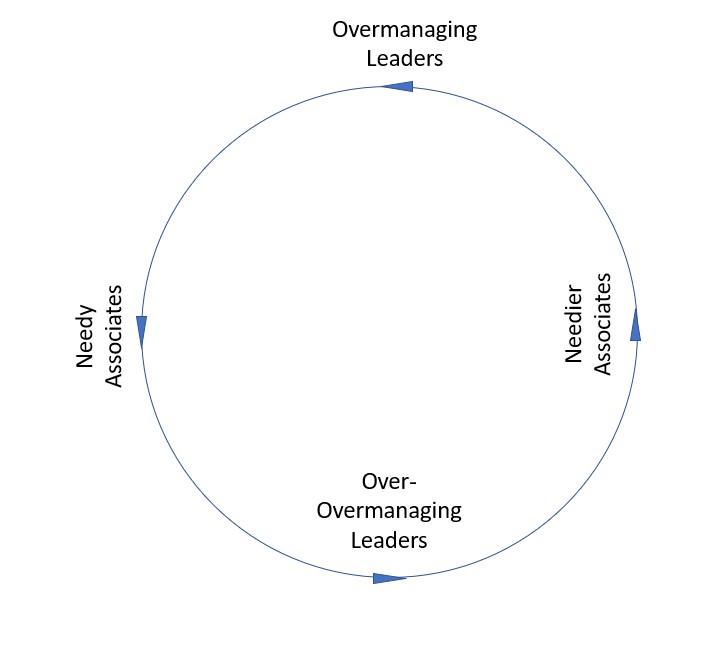Yet another holiday season is upon us. The second in the vicious grip of the runaway COVID virus. We have run halfway through the Greek alphabet trying to name these ever-evolving bugs. Anyway, the word ‘vicious’ got be thinking about a vicious circle that many organisations seem not to be able to come out of.

So, which came first? Overmanaging leaders or needy associates?
If I have to answer this question, I would, without hesitation, say overmanaging leaders. Overmanaging leaders focus on results and productivity measurements out of sheer long-term habit, rather than on processes like creating an enabling environment, reducing waste and inefficiencies and going for organisational success. And this creates a set of needy associates, who carry their ‘neediness’ all through their careers.
These needy associates keep coming to their managers for real or imaginary issues. Sometimes, they complain that they don’t get ‘support’ from their leaders when they need it. Many a time, people are unable to isolate the real issue they are facing. They go to management with vague support requests and become frustrated when ‘support’ is not forthcoming! Sometimes they just want reassurance that they are doing alright. They take up a lot of the manager’s time. One of the reasons such associates behave in this fashion could be that they previously used to work for micromanaging managers.
Of course, we need to understand that as their associates become ‘needier’, leaders tend to overmanage more and more. This makes the associates needier…
How does an organisation get out of this vicious circle? Such associate issues created by overmanaging managers become big bottlenecks in the organisation’s journey to success. I say that the main reason that new initiatives and transformation attempts do not succeed in an organisation is that executive leadership fails to play its role effectively in the transformation journey.
So what is the role of executive leadership to ensure that they don’t spawn this brood of needy associates?
Coming to the specific support issues raised above, the solution could be that the manager helps the associate build up their confidence. Maybe the associate is not really cut out for the work he is doing and he needs some training or mentoring. Or maybe the manager needs to tell the associate that they have to start tackling their problems themselves.
Let us not blame the leaders alone. In successful organisations, people, including leaders, work together and solve issues. You cannot throw an issue over to a manager, and then say that they have not solved it for you! Also, the ‘issue’ at hand may be new to the leader. Leaders can help only if people go to them with specific issues.
Let us look at some general approaches that leaders can employ so that they don’t create needy employees.
In general, the role of executive leadership is to create the environment for ensuring a culture where employees feel empowered. They need to create the awareness to sustain this culture and mindset, initiate the change in policies required, give people the space to challenge and grow, to experiment and change and eliminate waste, etc. They need to cultivate the sense of purpose among the associates to constantly improve and eliminate waste not only within themselves but also among colleagues.
Another key role of executive leadership is to help people in the organisation forge connections within and outside the organisation. Yes, and not only forge connections, but also encourage regular communication within the internal (including across multi-sites) and external networks. The ‘outside’ includes the customer as well as peer-groups and general information sources. One advantage of such networks is that it is not always ‘take, take’. You can provide inputs and help others, too. Being able to influence something in a positive manner is a big boost to one’s self-confidence and thus helps reduce ‘neediness’ among associates. Another way these networks are important is that they build visibility for individuals within their communities. This allows them to build their brand and enhance their resumes. This, in turn, builds the person’s self-esteem and thus, helps them contribute better.
Another key area, I think, is celebrating successes and encouraging the celebration of successes and to make work fun.
At the same time, the leadership needs to encourage experimentation that allows for, and not penalize, possible failure. Experimentation helps in finding the best ways to reduce waste. When we say ‘encourage experimentation and failure’, we must be sure that the message gets across at all levels of leadership that if there is failure, the questions asked should focus on the whys and not the whos.
Enterprises like the open source movement take care of this automatically. There is no place for ‘needy’ programmers. You do or die by yourself. There are no managers, as the term is currently understood, to manage you. Many of the people who work in the open software movement become part of different peer advisory groups, across sites, across organisations, and even across cities and countries. The advantage with such networks is that they provide a platform for group members to get critiques of their work and suggestions for improvement. They also are able to toss new ideas to one another for feedback and validation. The other advantage of being in these groups is that each member connects you to their connections and so on. Before you know it, you have established a good many strong connections. These networks also open up the possibility of forming connections even outside your industry, where you can get a “customer’s” feedback to what you are thinking about. These again help cut neediness among associates.




